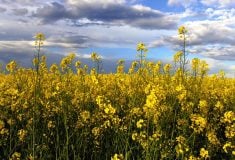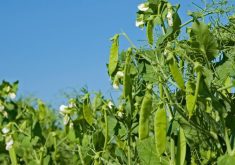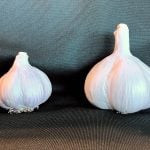MarketsFarm — Chickpea prices in Western Canada are on the rise due to tight supplies, according to one trader.
Prices for Kabuli chickpeas rose five cents per pound from last month, with high-delivered bids ranging from 40 cents/lb. for the seven-millimetre variety to 55.5 cents/lb. for 10-mm, according to Prairie Ag Hotwire. In comparison to a year ago, current per-pound prices are three cents lower to five cents higher.
Colin Young, manager of Mid-West Grain Ltd. at Moose Jaw, Sask., said the severe drought that hit the Prairies during the summer of 2021 greatly reduced chickpea production. Both domestic and global supplies of the specialty crop have not fully recovered.
Read Also

Ukraine will not limit wheat exports in 2025/26, says deputy minister
Ukraine will not restrict wheat exports in the 2025/26 July-June season due to a higher harvest and lower export rates at the beginning of the current season, deputy economy minister told Reuters on Wednesday.
“As we entered into (the 2022-23) growing season, we had the lowest global carryover stocks of chickpeas and followed it up with the lowest global seeded acreage in the last four years…Basically the world drew down stocks of chickpeas,” he said, adding that lower than normal Turkish and Russian supplies led to greater demand for Canadian chickpeas last month.
Canadian production of chickpeas was only 76,000 tonnes during the 2021-22 marketing year, 64 per cent less than the previous year, according to Agriculture and Agri-Food Canada (AAFC). The total is forecast to more than double to 157,000 tonnes for 2022-23 due to a rise in acres, but carryout stocks are set to decline by five per cent to 140,000 tonnes.
“Crops (didn’t have) a horrible (average) yield per acre by any means, but the stocks were tight,” Young said. “Some crops were above average (in quality) and some crops were just average. Compared to last year, a smashing success.”
Canadian chickpeas have received tenders from overseas markets, he noted, adding that demand should continue for a few months until India’s chickpea harvest next spring.
“There’s a wave of demand. Everyone purchases what they need to cover that demand, and then they kind of go quiet. We’re at the tail end of a heavy demand cycle in early November. I anticipate it’s going to be relatively quiet until after New Year’s and then there will be another wave of demand,” Young said. “The outlook between now and Valentine’s Day looks pretty firm.”
There is not too much willingness from buyers to purchase chickpeas at higher-than-current prices, according to Young, but the next wave of demand could change things.
“As we lead into the Christmas season, this is the market. The depth and strength of demand moving forward would dictate whether or not the next round of buying would see increases,” he said. “It’s likely it would, but it’s also anyone’s guess, as well.”
— Adam Peleshaty reports for MarketsFarm from Stonewall, Man.
















